1930 Gibson TG-0 Tenor Guitar
While this old gal is a bit on the worn-in side of things, it certainly sounds beautiful. It's also 100% original, right down to the endpin. A consignor sent this in for work and I slotted it ahead of a few of his other instruments, as it's always nice to have a tenor guitar around in the shop.
The factory order number is very faded (96xx?) but per Spann's book it correlates to 1930 or 1931. I'm guessing that means it's a 1930, per its specs, looks, and features. These are built just like the L-0 6-strings from the time, with 12-fret necks and super-lightweight bracing. I actually think these guitars (because of that extra-light bracing) sound more like Martin mahogany-top instruments than they do your average period Gibsons, really, but there is that sort of juicy, growly mids-response with a woody thwonk to the sound that Martins velvet-off instead.
Work included: a fret level/dress, re-repair with cleats to three longer cracks (2 on the top, 1 on the back), a couple of brace reglues, cleaning, and a good setup. It plays with spot-on hair-over 1/16" bass and 1/16" treble action at the 12th fret, a straight neck, and working truss rod. I have it tuned "Celtic" GDAE/octave mandolin tuning at the moment with gauges 42w, 28w, 18w, 12, though if it was going to be used for CGDA (standard) or DGBE tunings I'd lower the action to 1/16" overall.
Scale length: 22 3/4"
Nut width: 1 3/16"
String spacing at nut: 15/16"
String spacing at saddle: 1 3/16"
Nut width: 1 3/16"
String spacing at nut: 15/16"
String spacing at saddle: 1 3/16"
Body length: 19 3/8"
Lower bout width: 14 3/4"
Upper bout width: 10 1/4"
Lower bout width: 14 3/4"
Upper bout width: 10 1/4"
Side depth at endpin: 4 1/4"
Top wood: solid mahogany
Back/sides wood: solid mahogany
Neck wood: mahogany
Fretboard: rosewood
Back/sides wood: solid mahogany
Neck wood: mahogany
Fretboard: rosewood
Neck shape: flat board with medium C/V shape back
Bridge: rosewood
Saddle: original bone
Nut: original bone
Weight: 2lb 8oz
Condition notes: it has crazy amounts of usewear and tear but the finish is entirely original except for a couple spots around the soundhole where pickwear was touched-up with a little extra finish. I repaired the long cracks on the top and back, but there's old repairs to a punched-in tiny side crack and a filled-in 1/4" jack hole on the sides that are good to go. The cracks I re-repaired are not perfectly aligned up/down but they're all stable and pat. There's average wear-and-tear to the fretboard with just the most minor divoting of the board itself.
It comes with: a non-original, serves-for-storage chip case.
The saddle is low but I lengthened the (already long/wide) factory/worn-in string ramping behind it to give good back-angle over it. I also did just a minor amount of extra compensation to the top of the saddle to remove worn-in grooves and improve tuning.
The first top crack is on the lower bout...
...while the second one straddles the treble side of the bridge and next to the soundhole.
Original Grover geared pegs are nice to have!
The back crack is ugly, no? It's stable, however.
The factory order number is almost illegible but seems to be 9689 to my eyes.

























Comments